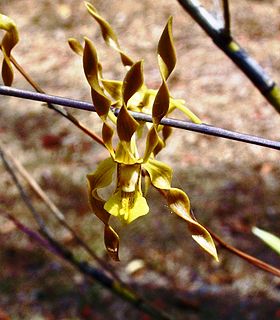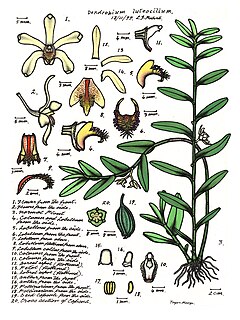
Dendrobium crumenatum, commonly called pigeon orchid, or 木石斛 is an epiphytic orchid in the family Orchidaceae and is native to Asia, Southeast Asia, New Guinea and Christmas Island. It has two rows on leaves along its pseudobulb and relatively large but short-lived, strongly scented white flowers. It usually grows in exposed positions in lowland rainforest and coastal scrub.

Dendrobium antennatum, commonly known as the green antelope orchid, is an epiphytic orchid in the family Orchidaceae. It has cylindrical pseudobulbs with up to twelve leaves near their tips and up to fifteen white flowers with green petals and a white labellum with purple stripes. It grows in New Guinea and in tropical North Queensland where it is rare.

Dendrobium discolor, commonly known as antler orchids, are epiphytic or lithophytic orchids in the family Orchidaceae. They have cylindrical pseudobulbs, each with between ten and thirty five leathery leaves, and flowering stems with up to forty mostly brownish or greenish flowers with wavy and twisted sepals and petals. Antler orchids occur in northern Australia, New Guinea and Indonesia and there are several subspecies and varieties.

Dendrobium smillieae, commonly known as the bottlebrush orchid, is an epiphytic or lithophytic orchid with large, spongy pseudobulbs, thin, bright green leaves which are shed after their first year and crowded flowers in a bottlebrush-like arrangement. The flowers are white, to cream-coloured or pink and the labellum has a shiny, dark green tip. This orchid species is found in some of the Torres Strait Islands, and through Cape York Peninsula to Townsville, Queensland. It is also found in New Guinea and eastern Indonesia.

Dendrobium trilamellatum, commonly known as the fragrant tea tree orchid or large tea tree orchid, is a species of epiphytic orchid found in northern Australia and New Guinea. It has spindle-shaped pseudobulbs, between three and seven leathery, dark green leaves and between three and fifteen yellow, yellowish brown or brown flowers with a mauve to purple labellum.

Dendrobium moorei, commonly known as the drooping cane orchid, is a species of epiphytic or lithophytic orchid in the family Orchidaceae and is endemic to Lord Howe Island. It has cylindrical pseudobulbs, leathery, dark green leaves and between two and fifteen small, white drooping flowers that do not open widely.
Dendrobium nativitatis, commonly known as the Christmas Island crimp orchid, is a species of epiphytic orchid that is endemic to Christmas Island, an Australian territory in the north-eastern Indian Ocean. It has long, straggly stems, flattened pseudobulbs, a single leathery leaf and a single pale yellow flower.
Dendrobium macropus, commonly known as the Norfolk Island cane orchid, is a species of epiphytic or lithophytic orchid in the family Orchidaceae and is endemic to Norfolk Island. It has cylindrical pseudobulbs, thin, dark green leaves and between five and ten yellowish green flowers that do not open widely.

Dendrobium falcorostrum, commonly known as the beech orchid, is a species of epiphytic orchid endemic to eastern Australia. It has spindle-shaped pseudobulbs, each with between two and five leathery leaves and up to twenty crowded white flowers with purple markings on the labellum.

Dendrobium agrostophyllum, the buttercup orchid, is an epiphytic or lithophytic orchid in the family Orchidaceae and has a creeping rhizome with well-spaced pseudobulbs. Each pseudobulb has up to twenty grass-like leaves, some of the leaves having flowering stems on the opposite side of the pseudobulb, each raceme with up to ten waxy, fragrant, bright yellow flowers. It grows in wet forest in coast areas of north Queensland, Australia.

Dendrobium bifalce, commonly known as the native bee orchid, is an epiphytic or lithophytic orchid in the family Orchidaceae. It has spindle-shaped pseudobulbs with up to four leathery leaves and up to ten pale green or greenish yellow flowers with purplish markings. It grows on trees and boulders in rainforest in tropical North Queensland, Australia and in New Guinea.

Dendrobium pruinosum, commonly known as the honey orchid, is an epiphytic or lithophytic orchid in the family Orchidaceae and has flattened, yellowish stems and pairs of cream coloured, dull yellow or greenish flowers. It grows in tropical North Queensland and New Guinea.

Dendrobium nindii, commonly known as the blue antler orchid, is an epiphytic or lithophytic orchid in the family Orchidaceae. It has erect, cylindrical, leafy pseudobulbs with leathery, dark green leaves and up to twenty mauve or violet flowers with darker veins on the labellum. This antler orchid occurs in tropical North Queensland and New Guinea.
Dendrobium convexum, commonly known as the piggyback orchid, is an epiphytic orchid in the family Orchidaceae. It has a creeping, brittle root, erect pseudobulbs with a single leaf on the top and one or two cream-coloured, short-lived flowers with a red and yellow labellum. It is native to Southeast Asia, New Guinea and tropical North Queensland, Australia.
Dendrobium clementsii, commonly known as the Cape York crimp orchid, is a species of epiphytic or lithophytic orchid that is endemic to tropical North Queensland, Australia. It has long stems, tapering pseudobulbs each with a thin, leathery dark green leaf and clusters of short-lived, cream-coloured flowers with a purple labellum.
Dendrobium epiphyticum, commonly known as the Illawarra rock orchid, is a species of epiphytic or lithophytic orchid that is endemic to New South Wales. It has tapered or cylindrical pseudobulbs, up to five thick, leathery leaves and up to fifty cream-coloured or pale yellow flowers with reddish purple markings on the labellum.
Dendrobium neospectabile, commonly known as the Eungella king orchid, is a species of epiphytic or lithophytic orchid that is endemic to tropical North Queensland. It has cylindrical, yellowish green pseudobulbs, up to three thick, leathery leaves and up to two hundred and fifty crowded cream-coloured to pale yellow flowers with reddish purple streaks on the labellum.
Dendrobium crassum, commonly known as the tableland feather orchid, is a species of epiphytic orchid that is endemic to tropical North Queensland. It has cylindrical, dark reddish brown pseudobulbs, up to three thick, leathery leaves and up to ten white flowers with purplish markings on the labellum.
Dendrobium deuteroeburneum, commonly known as the rainforest feather orchid, is a species of epiphytic or lithophytic orchid that is endemic to eastern Australia. Its pseudobulbs are cylindrical, pressed against the host tree or rock and have one or two leathery, dark green leaves and up to seven pale greenish cream-coloured flowers with purple markings on the labellum.
Dendrobium radiatum, commonly known as the brushbox feather orchid, is a species of epiphytic orchid that is endemic to eastern Australia. It has cylindrical pseudobulbs, up to three leathery, dark green leaves and up to eleven white flowers with purplish markings on the labellum.










